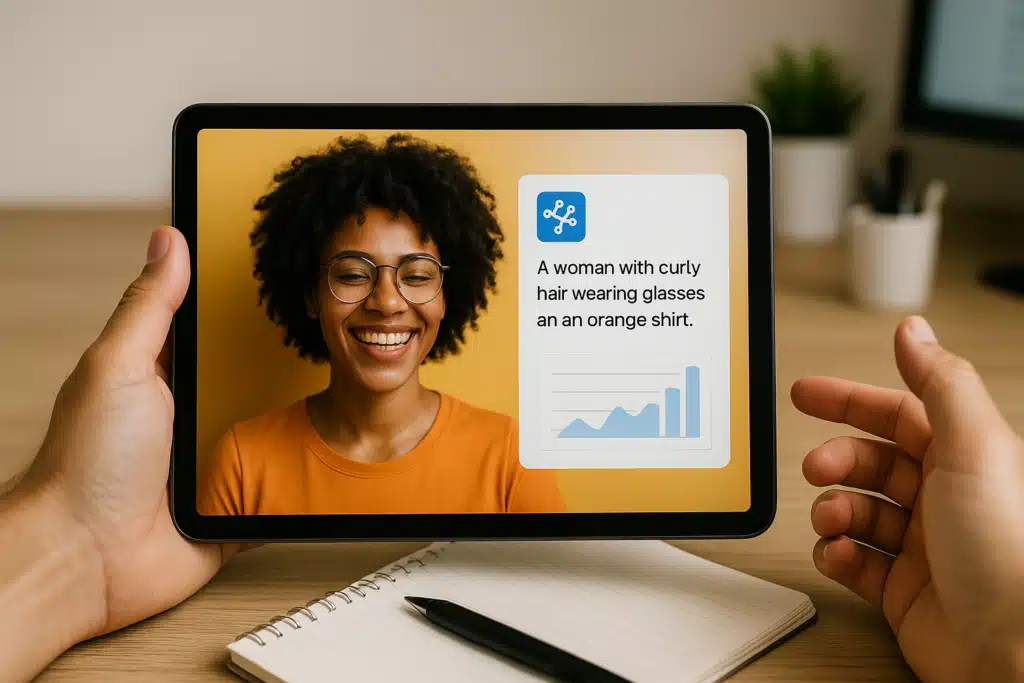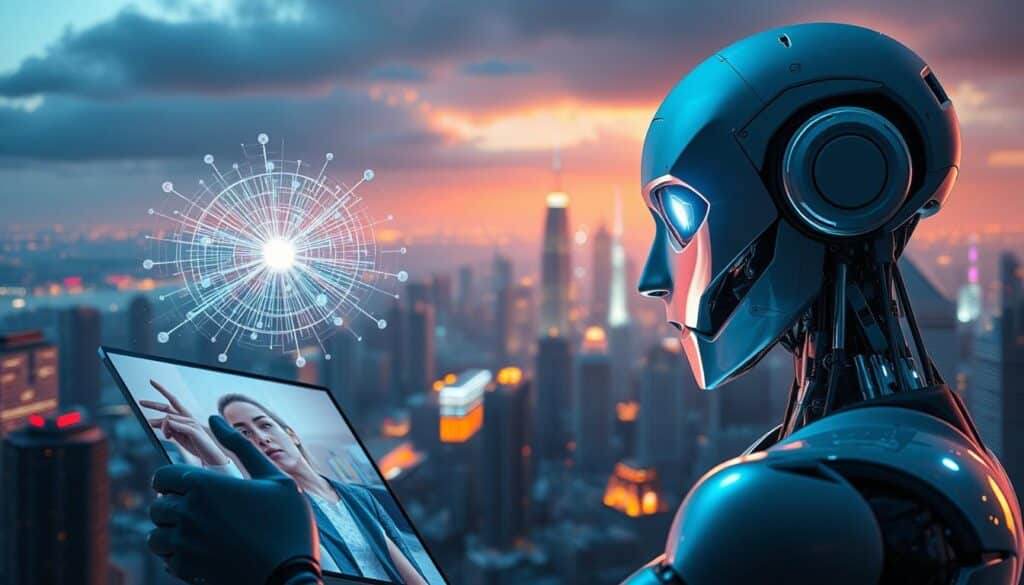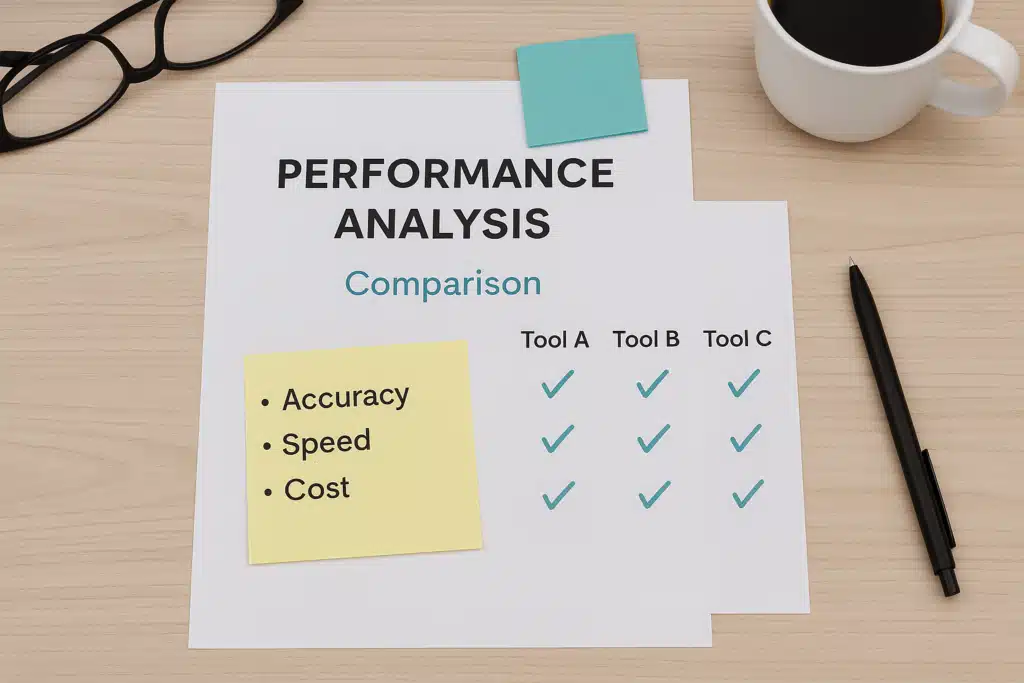Top 7 Best AI Image Describer Tools to Try in 2025
13 min read
Table of Contents
Did you know that nearly 1 in 5 people worldwide have some form of disability? Visual impairment affects about 285 million people globally. As visual content grows online, AI-powered image description tools are key for better accessibility and search engine optimization (SEO).

These tools use artificial intelligence to create text descriptions of images. They are vital for businesses, creators, and individuals wanting to boost their online presence. In this article, we’ll look at the top 7 AI image describer tools for 2025. We’ll discuss their features, benefits, and how they help with accessibility and SEO.
The Evolution of AI Image Describers in Visual Content
AI image recognition technology has made describing and understanding images better and faster. This change comes from advanced algorithms and deep learning. Now, machines can read visual data with great accuracy.

The Technology Behind Image Recognition
The main force behind AI image describers is deep learning and computer vision. These tools help machines see and understand images by spotting patterns and objects. Thanks to better neural networks and more training data, image recognition has gotten much better.
Now, AI image describers can give detailed descriptions of images. They can spot objects, scenes, and actions. This makes visual content more accessible and useful.
Why Businesses and Creators Need AI Image Description in 2025
In 2025, businesses and creators will use AI image description more. It will make their visual content better and engage users more. AI captions will help visually impaired users and improve SEO by giving search engines more image context.
Also, AI image describers will help businesses manage their images. They can follow brand rules and avoid posting wrong content.
How AI Image Describers Transform Content Accessibility
AI image describers are changing how we see online images. They create detailed descriptions for images, making them easier for the blind to understand. This helps everyone access online content more easily.
Benefits for Visually Impaired Users
For those who can’t see, AI image describers make the web more accessible. They give detailed descriptions of images. This lets users fully grasp the visuals, making online browsing fairer for all.
SEO Advantages of Proper Image Descriptions
Good image descriptions also boost SEO. They give search engines more info about images. This helps images show up better in searches, bringing more visitors to websites.
Content Moderation and Organization
AI image describers also help with content moderation and organization. They sort images based on their content. This makes it easier to keep online spaces safe and follow rules.
Key Features to Look for in an AI Image Describer
When picking an AI image describer, it’s key to look at its features. These features affect how well the tool works and how easy it is to use. There are a few important things to check.
Accuracy and Detail Level
The accuracy and detail level of the descriptions are very important. A tool that gives clear and detailed descriptions makes things better for users. Look for ones that are accurate and let you change the detail level as needed.
Language Support and Customization
Language support is also very important. It lets more people use the tool. Plus, customization options let users make the descriptions fit their needs. This makes the tool more useful.
Integration Capabilities
How well an AI image describer works with other systems is key. Integration capabilities make the tool easier to use and more valuable.
Pricing Models
It’s important to know the pricing models of AI image describers. This helps with budgeting and managing costs. Different models, like subscriptions or pay-per-use, offer different costs and flexibility.
Microsoft Azure Computer Vision
Microsoft Azure Computer Vision is a top-notch image analysis service. It helps businesses get insights from visual data. With advanced computer vision, it can analyze images and give detailed descriptions. This makes it perfect for many industries.
Overview and Core Capabilities
Microsoft Azure Computer Vision is made to handle and analyze visual data. It gives accurate and detailed info about images. Its main features include:
Key Features
- Image Analysis: It can spot objects, detect faces, and read text in images.
- Captioning: The service can write captions for images, summarizing their content.
- Tagging: Azure Computer Vision tags images with keywords, making them easier to find and organize.
Pros and Cons
Using Microsoft Azure Computer Vision has many benefits. It’s very accurate, scalable, and works well with other Azure services. But, some might find the pricing complex. Also, it might take time to learn for those new to computer vision.
Use Cases and Performance
Microsoft Azure Computer Vision is useful in many fields. Here are a few examples:
- Content Moderation: It helps keep content on social media and online services in check.
- Image Search: It makes image search better by adding accurate and relevant tags.
- Accessibility: It aids in making images more accessible for the visually impaired by providing detailed descriptions.
In summary, Microsoft Azure Computer Vision is a strong tool for analyzing and captioning images. It offers businesses a great way to get insights from visual data.
Google Cloud Vision AI
Google Cloud Vision AI is changing how we work with images. It uses advanced computer vision to help businesses get insights from pictures. This makes it easier to analyze and describe images.
Overview and Core Capabilities
Google Cloud Vision AI is a top-notch image annotation service. It uses computer vision and machine learning to classify images, detect objects, and read text.
Key Features
- Advanced image classification and object detection
- Text recognition and OCR capabilities
- Facial recognition and sentiment analysis
- Customizable models for specific business needs
Pros and Cons
Google Cloud Vision AI is very accurate and can handle a lot of images. But, it might need a lot of expertise to use fully.
The main benefits of Google Cloud Vision AI are:
- High accuracy in image annotation and analysis
- Scalable architecture for large-scale image processing
- Integration with other Google Cloud services
Use Cases and Performance
Google Cloud Vision AI is great for many things. It’s used for image moderation and content filtering and visual search and product recommendation. How well it works depends on the quality of the images and the task at hand.
In summary, Google Cloud Vision AI is a strong tool for working with images. It has advanced computer vision and can handle lots of images. Its features, advantages, and disadvantages make it a good choice for businesses looking to improve their image analysis.
OpenAI’s DALL-E and GPT Vision
DALL-E and GPT Vision, developed by OpenAI, are leading the way in image creation and understanding. These tools use advanced AI to make and explain pictures, changing how we describe images with AI.
Overview and Core Capabilities
DALL-E is known for making detailed images from text. GPT Vision is great at understanding and explaining pictures. Together, they offer a full solution for making and analyzing images.
Key Features
- Advanced Image Generation: DALL-E can create complex images based on detailed text prompts.
- Visual Interpretation: GPT Vision can analyze images and provide detailed descriptions.
- Customization: Both tools allow for customization to fit specific use cases and requirements.
Pros and Cons
DALL-E and GPT Vision are very accurate and can handle tough tasks. But, they need a lot of computer power and can be hard to add to other systems.
Use Cases and Performance
DALL-E and GPT Vision are used in many areas, like making content and graphics, and helping the visually impaired. They are known for their high accuracy and ability to create detailed, relevant images and descriptions.
In conclusion, OpenAI’s DALL-E and GPT Vision are changing the AI image world. Their advanced features and uses make them important for businesses and creators.
Amazon Rekognition
Amazon Rekognition is a top image analysis tool. It uses deep learning to find important details in visual data. It’s part of Amazon Web Services (AWS) and helps businesses understand their images and videos.
Overview and Core Capabilities
Amazon Rekognition uses deep learning to spot objects, people, and text in images and videos. It’s good at object detection, facial analysis, and content moderation.
Key Features
- Object and Scene Detection: Rekognition finds objects, scenes, and activities in images and videos.
- Facial Analysis: It does advanced facial analysis, like emotion detection and facial comparison.
- Content Moderation: Rekognition checks content for inappropriate or sensitive material.
Pros and Cons
- Advantages: It’s very accurate, scalable, and works well with AWS services.
- Limitations: It needs a lot of setup for some uses, and it can be expensive for big projects.
Use Cases and Performance
Amazon Rekognition is used in many fields, like security, media, and retail. It’s known for its accurate object detection and facial analysis. This makes it great for businesses that use a lot of visual content.
In retail, Rekognition can analyze customer behavior and preferences. In security, it improves surveillance by spotting and identifying people and objects.
Top AI Image Describer Tools for Specialized Needs
Advanced AI image describers meet specific needs in various industries. They offer businesses and creators solutions for their image description needs.
Clarifai
Clarifai is a top AI image describer known for its precision in recognizing visual content. Its deep learning models are trained on huge datasets. This lets it spot complex patterns and objects in images.
Standout Features and Use Cases
- Custom model training for specific industries or use cases
- High accuracy in object detection and image classification
- Integration with various platforms for streamlined workflows
Clarifai’s flexibility makes it great for many uses. It’s good for content moderation and visual search. It’s a strong tool for managing visual content for businesses.
IBM Watson Visual Recognition
IBM Watson Visual Recognition is a leading AI image describer for specific needs. It uses AI and machine learning to analyze visual content. This gives insights that help with business decisions.
Standout Features and Use Cases
- Advanced image classification and object detection capabilities
- Customizable models for specific business needs
- Integration with IBM’s ecosystem for enhanced functionality
IBM Watson Visual Recognition is great for companies wanting to enhance their content management. It also helps improve customer experiences with better image analysis.
Comparing the Best AI Image Describers: Performance Analysis
Choosing the best AI image describer requires a detailed performance analysis. We need to look at several important factors. These factors help us see how well these tools work.

Accuracy Comparison
The accuracy of AI image describers can differ a lot. For example, Microsoft Azure Computer Vision and Google Cloud Vision AI are top-notch. They are great at recognizing and describing images.
A comparison shows that both are very accurate. But, Azure Computer Vision might have a slight edge in complex images.
Speed and Processing Capabilities
Speed and processing capabilities are key. Tools like Amazon Rekognition and Clarifi are fast. They are perfect for tasks that need quick image analysis.
How fast a tool processes images affects the user experience. It’s important for tasks that need quick results.
Cost-Effectiveness Analysis
Cost-effectiveness matters a lot for businesses and creators. The pricing of these tools varies a lot. Some charge per use, while others have subscription plans.
OpenAI’s DALL-E has a flexible pricing model. This can be good for certain budgets. Looking at cost helps find the best tool for your needs and budget.
In summary, analyzing AI image describers involves checking their accuracy, speed, and cost. By comparing these, we can choose the right tool for our needs.
Conclusion: Selecting the Right AI Image Describer for Your Specific Needs
Choosing the right AI image describer is all about knowing what you need. Businesses and creators should think about things like how accurate it is, what languages it supports, how easy it is to use, and the cost. This helps make the right choice.
Microsoft Azure Computer Vision, Google Cloud Vision AI, and OpenAI’s DALL-E are top picks. Microsoft Azure Computer Vision is great at recognizing images. Google Cloud Vision AI, on the other hand, supports many languages.
Think about what your project needs. If you need high accuracy, Clarifai or IBM Watson Visual Recognition might be good. For those looking to save money, Amazon Rekognition is a good choice.
In the end, the right AI image describer makes your content better. It makes it easier to understand, helps with moderation, and keeps things organized. By looking at what each tool offers, you can find the one that fits your needs best.
FAQ
What is an AI image describer, and how does it work?
An AI image describer uses artificial intelligence to describe images. It uses deep learning and computer vision. This makes images more accessible and boosts SEO.
Why are AI image describers important for businesses and creators?
They make images more accessible and improve SEO. This helps visually impaired users and boosts business success online.
What is the difference between Microsoft Azure Computer Vision and Google Cloud Vision AI?
Azure Computer Vision offers detailed image analysis. Google Cloud Vision AI is great for image annotation and object detection. They serve different purposes.
Can AI image describers be used for content moderation?
Yes, they can analyze and categorize images. This helps detect and remove inappropriate content.
How do I choose the right AI image describer for my needs?
Consider accuracy, language support, integration, and pricing. Also, test the tool in your specific use case.
What are the benefits of using AI image describers for SEO?
They enhance SEO by giving search engines context about images. This improves image search rankings and overall visibility, driving more website traffic.
Reader Ratings & Reviews
There are no reviews yet. Be the first one to write one.
